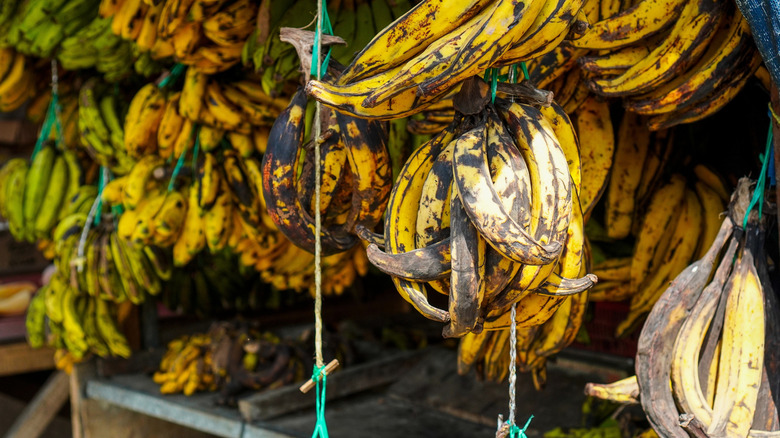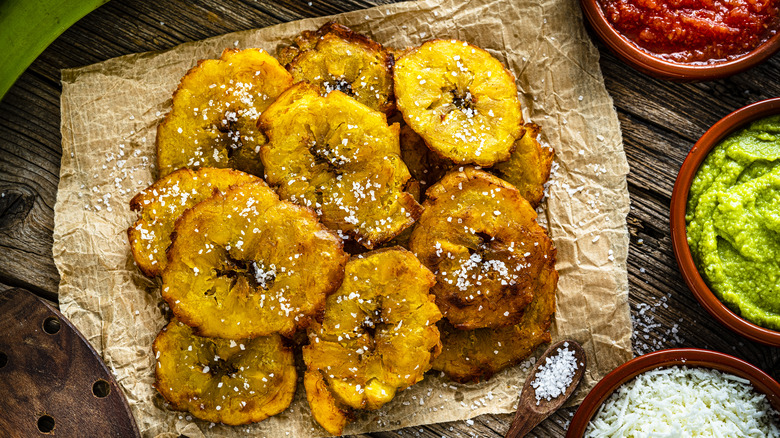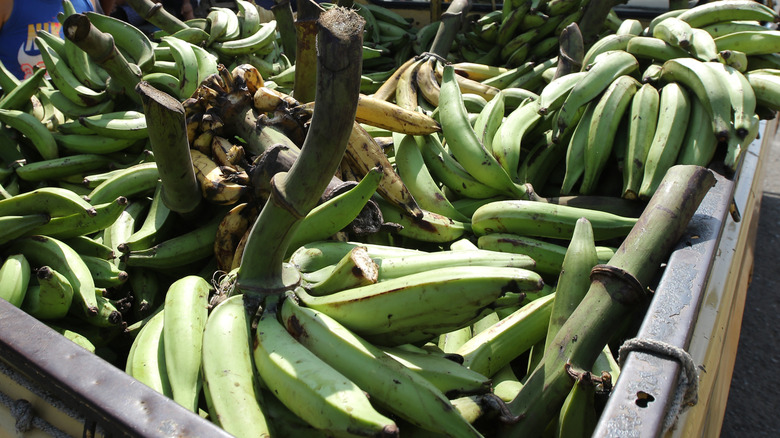The Sweetest Way To Cook Overripe Plantains
While bananas and plantains have their differences, one thing remains the same: as they ripen they both turn from green to yellow (and eventually brown and black) and become sweeter. You may already know that overripe bananas are the key to incredibly moist banana bread, but what's the best way to use overripe plantains? Food Republic got the answer from Hector Santiago of El Super Pan in Atlanta.
"If the plantains are fully ripened, I recommend deep frying them," he said. "If they're ripe but firm, slicing and deep or pan frying is best. Also, you can always bake them." Frying the plantains brings out their sweetness from the sugars that develop while ripening. To do it, Santiago recommends using soy, canola oil, or clarified butter at 325 degrees Fahrenheit.
Once fried, Santiago recommends seasoning them with sweeter spices like cinnamon, allspice, and nutmeg for the ultimate sweet plantain dish. You can also use ginger, lemongrass, coconut, and chiles, or even pair them with a minty, citrusy sauce. For a fun twist, Santiago suggests mashing the fried plantains (also called maduros) and seasoning them with some chipotle and lime or orange zest.
Other ways to use plantains
If you're not in the mood for frying or baking overripe plantains, there are a few other suggestions Hector Santiago has for using them. "You can make all kinds of things with overripe plantains including 'banana' vinegar, plantain muffins, gnocchi, sweet savory mustard for hot dogs, or caramelized plantains," he said.
Of course, you don't have to wait for your plantains to overripen to enjoy them — they just won't be quite as sweet. "If they are semi ripe but still starchy, they can be made into a toston (keeping in mind they will be slightly sweet) or mofongo," Santiago said. Use the same type of oil, but adjust the temperature to around 350 degrees Fahrenheit. Then, sprinkle on salt, cumin, coriander, garlic, pork cracklings, chiles, or lime for a savory snack or side.
"If they're completely ripe but still firm, they can be made into tajadas, sliced thinly then cooked then made into a 'lasagna,' which is one of my favorites." To do it, slice the plantains into strips, fry them, and then layer them with your other lasagna ingredients.
How to choose and store plantains
When you're picking out your plantains, it's important to look for the right color and, in some cases, check their weight. "When it comes to green plantains, they should have a 'fluffy' look to them and feel 'light' not heavy," Hector Santiago said. "With ripe plantains, an even yellow color is what I prefer."
Once you have your plantains, be sure to store them properly for maximum freshness. Santiago said, "If they're green, store them in the refrigerator so they don't ripen on the counter. If they need to continue ripening, keep them in a paper bag on the counter." To ripen them more quickly, you can also add an apple or a banana to the bag.
If you want to keep them even longer, you can also freeze them, but only if they're ripe. Santiago warns against freezing green plantains to avoid having their taste and texture turn cardboard-like. Similarly, he recommends not freezing tostones, which are made from green plantains, unless they're made from Hawaiian plantains.



